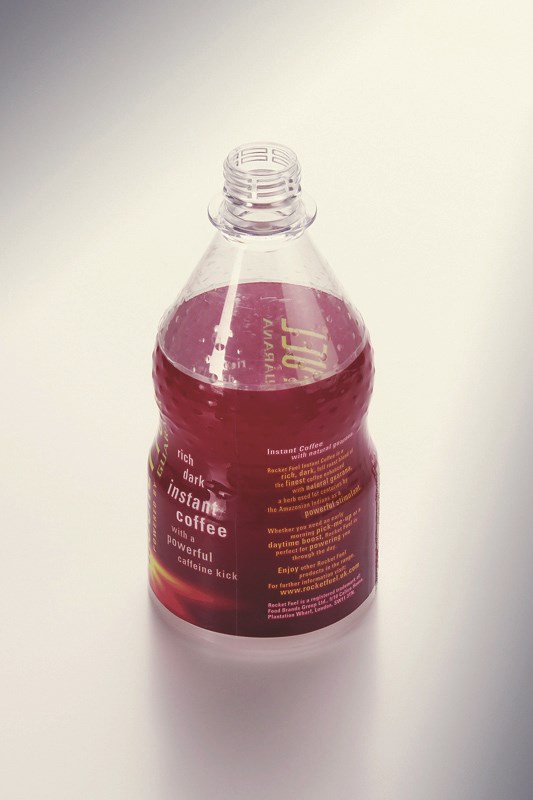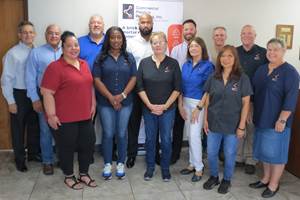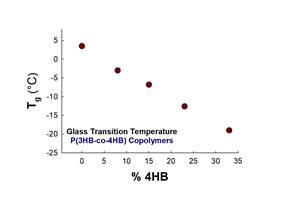Shrink-sleeve labels: You see the eye-catching designs everywhere these days on food, beverages and consumer products. Brand owners love them because they offer plenty of real estate on the container to communicate what the product is and overall messaging on a 360° marketable area of the package. And the trend isn’t slowing down—the shrink-label market is expected to grow at a 5.2% annual rate through 2021, reaching $245 million in sales, according to The Freedonia Group’s study, Stretch & Shrink Sleeve Market in the U.S.
While the labels are a success story for brands, they also present a headache for recyclers. About 20 years ago, PVC had the largest market share of shrink-film labels. But 10 years ago, the industry started shifting away from PVC shrink labels because of environmental concerns.
“It’s highly undesirable to have PVC mixed with PET in recycling,” says John Standish, technical director of the Association of Plastics Recyclers (APR), Washington, D.C. “One of the most important steps in recycling PET is called ‘float and sink’ and PVC has a high density and sinks in the water. It gets mixed in with PET and gets trapped in the ‘float and sink’ step.”
The industry started to shift to PETG-based film, but that also created issues for recyclers. According to a 2014 APR report, shrink-sleeve labels that are PVC-based or PETG-based film have a density higher than water and can’t be separated from PET flakes during the sink-float separation step of the recycling process, so they contaminate the recycled PET stream and deteriorate the quality of recycled PET (rPET) products.
With the increased usage of these labels, recyclers were experiencing a rising volume of shrink-labeled PET containers that were not recyclable. It is estimated that PET bales contain approximately 5% shrink-labeled containers. The challenge of removing shrink labels during PET recycling was brought to the industry’s attention by APR and the National Association of PET Container Resources (NAPCOR), Florence, Ky., in 2012. APR established guidelines for label manufacturers and an official Critical Guidance Recognition program to encourage development of labels that are more compatible with PET bottle recycling systems.
But the big push came from brand owners: Coca-Cola, PepsiCo, Walmart, and Unilever are among those who have made pledges to use 100% recyclable, reusable or compostable packaging by 2025.
“Labels create a variety of challenges, as they add to the complexity for the PET recycler,” Standish says. “But thanks to brand-owner requirements, the recycling aspect is a must-have. We know major brand owners are evaluating the options and we believe that 2018 will be the year we start to see the new options in the marketplace.”
DESEAM & RELEASE LABEL ADHESIVE
Eastman Chemical, Kingsport, Tenn., has been in the shrink-film label market since the early 1990s. Early polyester-based shrink labels consisted of blends of several different types of polyester, but in the late 1990s Eastman developed a reactor-grade resin that had very unique shrinkage properties, says Ronnie Little, Eastman’s market-development manager, SP-Plastics Packaging. This patented resin has become the industry standard for shrink-film labels.
Eastman Embrace LV copolyester (PETG-based) enables differentiated labeling wrapped around highly contoured, complex and thin-walled containers, and it displays 75% ultimate shrinkage. Little says that shrink labels made from Embrace resins are on some of the most recognizable brands in the world. A few examples include Method soaps and household cleaners, Malibu rum, Jack Daniels, 94Wines and Bayer garden products.
However, there is still the recyclability concern. Eastman has been very vocal about working to find a solution and in 2012, organized a consortium to collaborate on ways to solve this issue. Little says that as result of the work of the consortium, Eastman partnered with ink maker Sun Chemical, Parsippany, N.J., to advance the development of a deseamable adhesive. The result is Sun Chemical’s SunLam Deseaming Adhesive. By changing from a traditional solvent to use of SunLam Deseaming Adhesive, shrink labels deseam and release during the bottle-wash step of the wet recycling process.
Little says that for brand owners, this can be done with minimal process changes or additional investment in new equipment. The only change needed is the adhesive. The label removal occurs prior to color, infrared and manual sorting, thus preventing shrink-labeled PET bottles being removed from the rPET stream due to misidentification.
“Eastman’s partnership with Sun Chemical to develop deseaming had both companies walking into unchartered territory,” Little says. “Eastman and Sun extensively tested SunLam on labels made with Eastman Embrace LV copolyester.”
According to Little, they ran thousands of shrink-labeled containers at commercial recycling facilities to determine the effectiveness of label separation. Test variables included time in the actual recycling process, temperature of the recycle wash water, and the caustic level of the wash water. This led to optimizing the deseaming adhesive formulation to work efficiently, allowing the shrink label to come off the PET bottle prior to sortation. The result is a label-free PET container ready to be processed into rPET.
SunLam Deseaming Adhesive has received a “Responsible Innovation Acknowledgment” after passing testing outlined by APR. The tests utilized whole-bottle wash equipment at commercial recycling facilities and yielded results of greater than 95% label removal, with results typically exceeding 99%.
“Removing shrink-sleeve labels early in the recycling process virtually eliminates misidentification of PET bottles during sorting, as well as contamination that occurs in the sink-float separation process,” Little says. “Not only do labels seamed with SunLam Deseaming Adhesive release during the whole-bottle wash, the adhesive also forms a strong bond on the shrink-sleeve label that lasts through all phases of the PET bottle’s life cycle, from the sleeve shrinking, through transporting to store shelves, and consumer use.”
FLOATABLE SHRINK FILMS
Timothy Kneale, president of Topas Advanced Polymers, Florence, Ky., joined the company in 2004 and said that the company’s work in sleeve labels was already taking place with multiple commercial users of labels from various film producers. As the usage of sleeve labels continue to grow each year, Topas became focused on a drop-in option to the current recycling infrastructure.
“We have been working on a solution that enables shrink labels to float, and we’re seeing a lot more interest in that as time goes on and consumers and brand owners get more serious about demanding effective recycling solutions,” he says. “You see the commitments from big beverage companies and Walmart—the big players are coming together and drawing a line in sand that by 2025, this must be fixed.”
Enter Topas’ cyclic olefin copolymer (COC) material for shrink applications. These polyolefin film structures will float during the washing stage to facilitate separation of label and bottle materials. Kneale said floatable labels are made by multi-layering COC with PE or PP.
Kneale says that PP has a density around 0.90 g/cc, and LLDPE around 0.92. These are coextruded with COC (1.01 g/cc) so that the final structure is in the 0.95 or lower density range.
“This means the labels will float even with ink applied,” he says. “We believe the floatable solution is the best; it’s universally applicable, and every MRF (Material Recovery Facility) can do this. There’s no additional equipment to buy; it’s a perfect drop-in for recyclers.”
Topas says that COC shrinkage can be as high as that of PVC or PETG, and the Topas COC enables label manufacturers to make low-density, flotation-separable labels that meet the APR guidelines. “The COC brings high shrink, high gloss, great ink adhesion, easy cutting of labels, and high stiffness,” Kneale says. “These are all things that ordinary polyolefins (PP, PE) do not do well by themselves.”
“Labels create a variety of challenges, as they add to the complexity for the PET recycler.”
One processor running Topas COC is Taghleef Industries of Dubai, United Arab Emirates, a supplier of films to the global marketplace. Kneale says that the Taghleef film passed all of APR’s flotation tests, which confirms that the label stock will float in water and that the label does not interfere with the color or haze of recycled PET. In 2017, Taghleef introduced its polyolefin TDS label film that is clear and floatable, with up to 65% shrinkage.
Other processors that have developed floatable solutions meeting APR’s guidelines include Klöckner Pentaplast, Gordonsville, Va., with its Pentalabel ClearFloat; and UPM Raflatac, Mills River, N.C. UPM Raflatac says that during the recycling process, its RafShrink PO MDO 40 HS film ensures clean separation from clear PET bottles by floating to the top of the caustic washing solution, unlike PVC and PETG labels, which sink with PET bottle material.
“What’s exciting now is there’s all these different options,” APR’s Standish says. “The view of PET recycling is that I don’t care which one you use —just do something different, get new materials in the market and gain experience, and let’s all move forward with recycling.”
Related Content
The Importance of Mass Balance in Chemical Recycling
Approaches to mass balance can dramatically impact calculations of recycled content.
Read MoreInside the Florida Recycler Taking on NPE’s 100% Scrap Reuse Goal
Hundreds of tons of demonstration products will be created this week. Commercial Plastics Recycling is striving to recycle ALL of it.
Read MoreFilm Extrusion: Boost Mechanical Properties and Rate of Composting by Blending Amorphous PHA into PLA
A unique amorphous PHA has been shown to enhance the mechanical performance and accelerate the biodegradation of other compostable polymers PLA in blown film.
Read MoreNPE2024 Wrap-Up: Sustainability Dominates Show Floor News
Across all process types, sustainability was a big theme at NPE2024. But there was plenty to see in automation and artificial intelligence as well.
Read MoreRead Next
People 4.0 – How to Get Buy-In from Your Staff for Industry 4.0 Systems
Implementing a production monitoring system as the foundation of a ‘smart factory’ is about integrating people with new technology as much as it is about integrating machines and computers. Here are tips from a company that has gone through the process.
Read MoreFor PLASTICS' CEO Seaholm, NPE to Shine Light on Sustainability Successes
With advocacy, communication and sustainability as three main pillars, Seaholm leads a trade association to NPE that ‘is more active today than we have ever been.’
Read MoreLead the Conversation, Change the Conversation
Coverage of single-use plastics can be both misleading and demoralizing. Here are 10 tips for changing the perception of the plastics industry at your company and in your community.
Read More

























